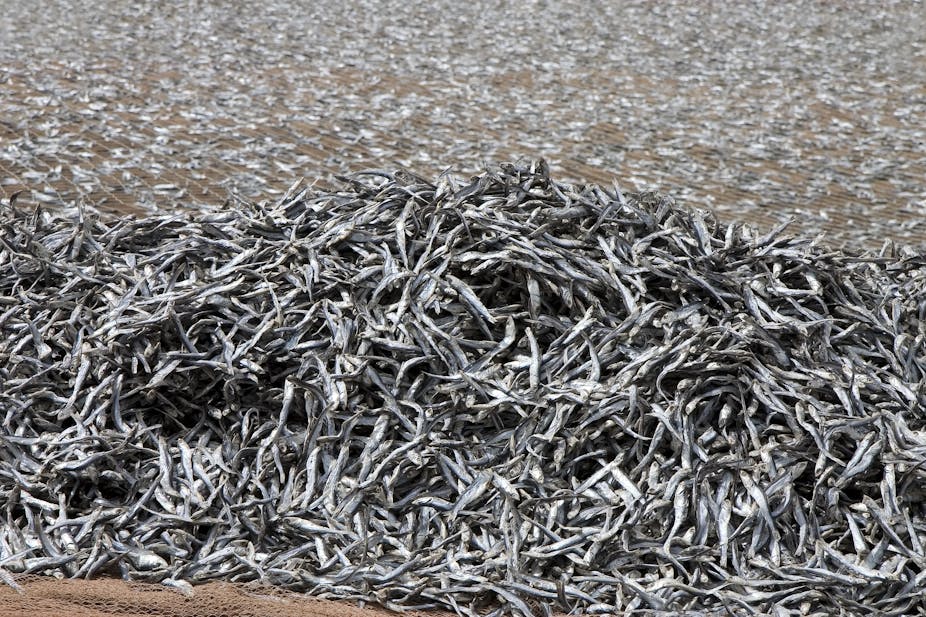“That’s obscene,” I thought when I saw the photo of Helena Bonham Carter, nude, clasping a tuna between her legs and gazing lovingly into its face. She declared the fish was her “Valentine”. My Western, 21st century eyes weren’t in the least offended by the actor’s nudity. It was the corpse that bothered me, the way it was being sexualised, displayed, humiliated. It was then that I realised I was identifying with the tuna rather than the human.
The picture of Helena Bonham Carter and her Valentine is one in a series that’s part of a campaign aiming to raise awareness and funds to prevent the overfishing and possible extinction of many sea creatures, so that:
People will be able to eat fish for generations to come, and … people who depend on fishing for their livelihoods can continue to do this into the future.
It’s far from an animal-rights or vegan message, but is perhaps a good second-best given that for most people veganism and even vegetarianism are still unthinkable. This campaign’s power comes from a serious tension: it asks us to recognise fish as beautiful, as having experiences and lives worth living, but at the same time it promotes them as food. Bonham-Carter’s Valentine will also be her supper.
The photos are beautifully confronting. Sean Pertwee’s monkfish hangs like a penis so large he can barely hold it up; Jade Parfitt has starfish for nipples. The smoky blue skin of the hake that Richard E Grant cradles matches his eyes — they could be father and child — while Steven McRae is doing a pas de deux with his ling. Tom Aikens holds a wolf fish close and tight, Jerry Hall and Lizzy Jagger brandish terracotta-coloured scorpionfish like prized handbags and Lily Loveless “wears” an octopus of the most delicate pearlescent grey. It is only Jean-Marc Barr, eyes closed as if in mourning as he embraces a Mako Shark the same size as him, who seems to portray sorrow about the dead creature.
There is a long history of humans posing with dead animals to demonstrate power, sexual prowess, and glamour: the trophy shots of the felled rhino with the hunter’s boot on its neck, the nude woman lounging on the bearskin rug. These pictures are about exoticism and possession, about owning creatures different to us and taming the wild.
Many people now find them appalling, interesting for historical reasons but not to be imitated in today’s enlightened world. We condemn the likes of Melissa Bachman for shooting Big Game in Africa, we don’t buy fur, we no longer use whale oil to make soap and paint. Why?
A cynic would say it is because we have cheaper alternatives and that hunting is out of reach for most people, so easy to target as abhorrent while we ignore what happens inside the black boxes of abattoirs. But it’s also because, over the past 50 years, we have come to identify with certain creatures through a range of awareness-raising campaigns. We have learned that whales sing, that rhinos are beautiful, that bears are better in the woods than on our floors. Identification, even perhaps anthropomorphism, and resulting empathic feelings have led to many creatures no longer being used by humans in the ways they once were.
But fish are a hard sell. Besides insects and microscopic creatures, what could be more different from humans than fish? In a sense, they inhabit a different world. They look, feel and smell weird. It’s harder to think of them as having feelings than, say, cows or pigs (which is perhaps why so many who call themselves vegetarians happily keep on eating fish).
And this is why this campaign is so interesting. It’s inviting us to be intimate with fish, to put our skins next to their scales, to hold them, to look them in the eye, to think a little about what the brilliant sociologist Elspeth Probyn calls “human-fish-water entanglements”
The photo of C Arestis and E Watson entwined with a Conger Eel shows this entanglement, demonstrating with one picture how we are plaited with animals, how they are part of us, intricately connected with our cultural and social histories, whether we continue to ingest them or not.
My horror at the corpse gave way to admiration for an intelligent and realistic campaign that encapsulates one of the most important questions we face when it comes to living ethically: how to deal with the tangled and complex relations we continue to have with non-humans. A campaign like this could be a first step to recognising sea-creatures the way that many people now recognise gorillas — not as meat but as kin.

